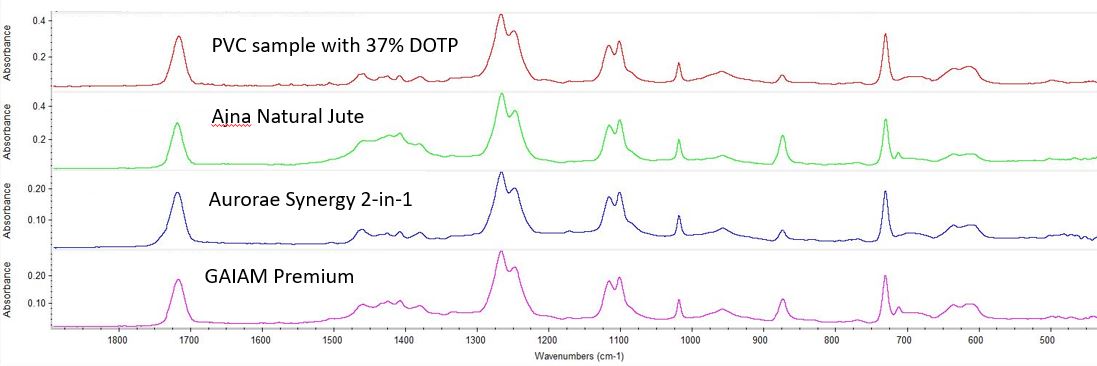At the Ecology Center we have tested thousands of consumer products made from various polymers, including flexible PVC (polyvinyl chloride) containing plasticizers. We can identify polymer types as well as reliably detect plasticizer chemicals such as ortho-phthalate esters (abbreviated “phthalates”), dioctyl terephthalate (DOTP), DINCH, dibenzoate esters (Benzoflex), triphenyl phosphate, adipates, and trimellitates. We have repeatedly validated our FTIR identification of these materials through having samples tested at commercial laboratories using certified methods.
Fourier Transform Infrared Spectroscopy (FTIR) analysis
A Nicolet iS5 FTIR spectrometer with an attenuated total reflection (ATR) accessory was used to identify the polymer type of the yoga mats as well as major additives. Absorbance spectra were collected from 4000-500 cm-1. To identify materials, we used a combination of visual inspection of the spectral data by an expert researcher along with searching for matches in a spectral library purchased from Thermo Scientific.
The output of the FTIR instrument is an absorbance spectrum that is unique to the molecular structure of the material. For example, a polyethylene spectrum is distinct from a polypropylene spectrum. Infrared spectra are best interpreted by a spectroscopy expert through a combination of visual verification of absorbance peak positions and matches to known reference spectra.
The image below shows stacked infrared spectra from the three yoga mats we found to contain PVC and DOTP, along with a reference sample of verified composition. The reference sample was determined to be composed of PVC and DOTP through our FTIR and XRF testing and was measured to contain 37% DOTP by weight by a certified third-party laboratory using Method CPSC-CH-C1001-09.3.
The matching overlap of PVC bands (637 and 615 cm-1) and DOTP bands (1267, 1249, 1117, 1102, 1020, 731 cm-1) in the four spectra are apparent.
X-ray fluorescence (XRF) analysis
High Definition X-ray Fluorescence (HD XRF) is an elemental analysis technique with greater sensitivity than standard XRF. Our instrument from XOS uses monochromatic excitation energies of 7, 17, and 33 keV. The spot size is one millimeter. Elements heavier than aluminum are measurable.
Detection limits are in the low parts-per-million (ppm) or sub-ppm range for all elements of interest in this study except chlorine. For chlorine we consider results above 1,000 ppm to be at least semi-quantitative. Items made from PVC (polyvinyl chloride) typically contain chlorine at tens or hundreds of thousands of ppm.
XRF is also quantifies heavy metals, such as lead and antimony.
References:
Socrates, G. (2001). Infrared and Raman characteristic group frequencies (3rd ed.). Chichester, UK: Wiley
HR Polymer Additives and Plasticizers, FTIR spectral library from Thermo Fisher Scientific.



